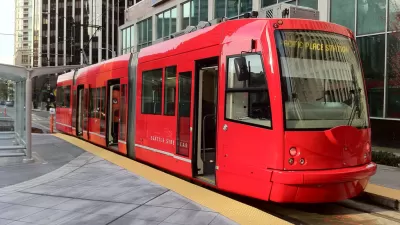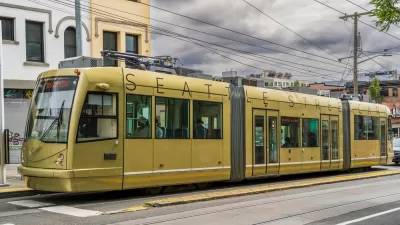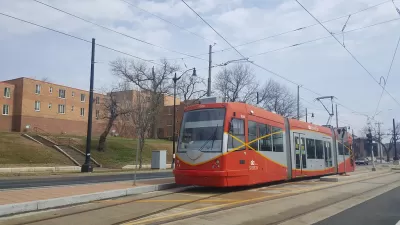A new streetcar extension would complete Seattle's streetcar network in a particularly busy corner of the city's downtown. The mayor doesn’t seem enthused with the idea, even if riders are already enthused with streetcars.

Jon Talton writes a column to lament the failure of the Center City Connector, a 15-block streetcar extension that would complete a streetcar network in several neighborhoods around Downtown Seattle.
"For a city with so much luck, Seattle has done repeated face plants in attempting to build necessary rail transit," writes Talton. "Never miss an opportunity to miss an opportunity. Shoot ourselves in the foot and reload."
This take on Seattle's lack of transit investment might come as a surprise to outsiders, who regularly read of transit success in the city, from increasing bus ridership to increased ridership on waterborne transit to declining solo car commuters. But, Talton cites a significant historical episode to make his case for Seattle as a public transit cautionary tale: "The most notorious mistake was the 1970 failure to pass bonds to build a regional subway system, which would have been 75 percent funded by the federal government."
With the Center City Connector, Talton notes that Mayor Jenny Durkan shelved the project in March (as reported at the time by David Gutman) to study project expenses. According to Talton, the lack of a complete streetcar system would be shame. Unlike other streetcars around the country, Seattle's current system is transporting increasing numbers of users.
"The Center City Connector, which would mostly run along First Avenue from Pioneer Square to meet the South Lake Union line, would be an especially sweet spot for passengers. Among the destinations: Pike Place Market, the Seattle Art Museum, and, nearby, the waterfront and the ferry and cruise terminals," according to Talton.
FULL STORY: Center City streetcar line would complete badly needed transit link

Planetizen Federal Action Tracker
A weekly monitor of how Trump’s orders and actions are impacting planners and planning in America.

Maui's Vacation Rental Debate Turns Ugly
Verbal attacks, misinformation campaigns and fistfights plague a high-stakes debate to convert thousands of vacation rentals into long-term housing.

San Francisco Suspends Traffic Calming Amidst Record Deaths
Citing “a challenging fiscal landscape,” the city will cease the program on the heels of 42 traffic deaths, including 24 pedestrians.

Defunct Pittsburgh Power Plant to Become Residential Tower
A decommissioned steam heat plant will be redeveloped into almost 100 affordable housing units.

Trump Prompts Restructuring of Transportation Research Board in “Unprecedented Overreach”
The TRB has eliminated more than half of its committees including those focused on climate, equity, and cities.

Amtrak Rolls Out New Orleans to Alabama “Mardi Gras” Train
The new service will operate morning and evening departures between Mobile and New Orleans.
Urban Design for Planners 1: Software Tools
This six-course series explores essential urban design concepts using open source software and equips planners with the tools they need to participate fully in the urban design process.
Planning for Universal Design
Learn the tools for implementing Universal Design in planning regulations.
Heyer Gruel & Associates PA
JM Goldson LLC
Custer County Colorado
City of Camden Redevelopment Agency
City of Astoria
Transportation Research & Education Center (TREC) at Portland State University
Jefferson Parish Government
Camden Redevelopment Agency
City of Claremont





























